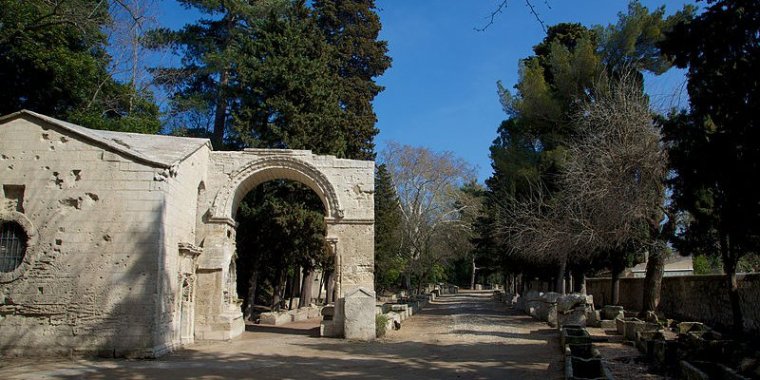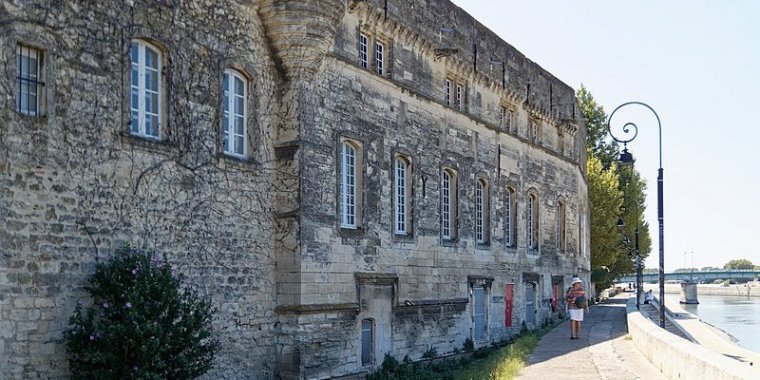| Travel / Destinations |
Arles, France
Arles is a city and commune in the south of France, in the Bouches-du-Rhône department, of which it is a subprefecture, in the former province of Provence.
The city has a long history, and was of considerable importance in the Roman province of Gallia Narbonensis. The Roman and Romanesque Monuments of Arles were listed as UNESCO World Heritage Sites in 1981. The Dutch post-Impressionist painter Vincent van Gogh lived in Arles from 1888 to 1889 and produced over 300 paintings and drawings during his time there.
Climate
Arles has a Mediterranean climate with a mean annual temperature of 14.6 °C (1948–1999). The summers are warm and moderately dry, with seasonal averages between 22 °C and 24 °C, and mild winters with a mean temperature of about 7 °C. The city is constantly, but especially in the winter months, subject to the influence of the mistral, a cold wind which can cause sudden and severe frosts. Rainfall (636 mm per year) is fairly evenly distributed from September to May, with the summer drought being less marked than in other Mediterranean areas.
Tourist Office
• Boulevard des Lices, +33 4 90 18 41 20, e-mail: ot-arles@arlestourisme.com. April-Sept: Mon-Sat 9h00-18h45; Oct: Mon-Sat 9h00-17h45, Sun 10:00-13:00; Rest of the year: Mon-Sat 9h00-16h45, Sun 10:00-13:00.
Get in
By train. Gare d'Arles (train station), Avenue Paulin TALABOT.
By bus. There are several bus lines from towns all over the Bouches-du-Rhône. You can always buy your passage from the conductor.
By car. Take the Autoroute from Salon or yet another from Marseille, but give preference to the smaller routes and Alpilles towns like Fontvieille, Paradou, les baux, etc.
Get around
Arles is for the most part small enough to enjoy by foot, if you aren't lazy. Otherwise, rely on taxis and buses. It's not even worth doing anything besides walking. Rent bicycles for day trips in the alpilles.
What to See in Arles
• Arènes d'Arles (Roman ampthitheatre). was built in the first or second century B.C. houses Corridas at Easter and the Rice Festa in September. Throughout the summer there are various courses camarguaises (bloodless bullfighting).
• Théatre Antique d'Arles (Classical theatre). 10:00 to 18:00 except Tuesday. It was built at the end of 1st century BC. €8 (free every first Sunday of the month and for children up to 18).
• Cryptoportiques (Cryptoporticos) (Place de la Republic and Place du Forum). Now completely underground, the cryptoporticos, a semi-subterranean gallery, was a sort of a base for the Roman Forum in Arles. It was built at the end of 1st century BC. The current structure has a horseshoe form. The entrance is located inside the Hôtel de Ville d'Arles (aka Mairie d'Arles).
• Thermes de Constantin. The remains of the Roman baths.
• Cathédrale Saint-Trophime (Church of Saint Trophime). A church in Romanesque style built in XIIth century. Besides the church there is a quite remarkable cloister.
• Espace Van Gogh (Médiathèque & Bibliothèque Municipale), Place Docteur Félix Rey, +33 4 90 49 39 39. A former hospital with a courtyard where Van Gogh was kept under medical treatment.
• Alycamps. An ancient burial site and early Christian cemetery. Eglise Saint Honorat is at the SE end of the place.
• Pont de Langlois (Pont Van Gogh) (quite a bit out of the city centre). It was the subject of several paintings by Vincent van Gogh.
• Musée de l'Arles et de la Provence antiques (Musée de l'Arles antique), Presqu'île-du-cirque-romain BP 205, +33 4 13 31 51 03, e-mail: info.mdaa@cg13.fr. An archeological museum of Arles. At the NE side of the museum there are some very scarce remains of the Roman circus.
• Musée Réattu (Fine Arts museum), 10, rue du Grand Prieuré, +33 4 90 49 37 58. Tuesday to Sunday, November-February: 10am to 5pm, March-October: 10am to 6pm. €8.
• Museon Arlaten, 29-31 rue de la République, +33 4 13 31 51 99, e-mail: museon.arlaten@cg13.fr. Closed for renovations until 2018.
What to Do in Arles
The Market and definitely think about researching for expositions and other events of the sort.
Buy
• Markets and brocantes.
• Check out the Saturday market for sure.
Eat
Saucisson d'Arles (traditionally made with a bit of donkey meat), marinated olives from the market, Languedoc cheeses from the market, etc. Other dishes: Gardianne de Boeuf, Daubes, Fougasse d'Arles (with duck confit inside)
For restos, check out the menus on side street restaurants.
• La Bohême, 6 Rue Balze, +33 4 90 18 58 92.
• La Mule Blanche, 9 Rue du Président Wilson, +33 4 90 93 98 54.
• Querida, 37 rue des Arenes, +33 4 90 98 37 81. lunch from 12pm; dinner from 7pm; closed Tue&Wed.
Drink
• Pastis, the local wines are good with food. Take advantage of the proximity of Nîmes for wines.
• There's the embarrassingly touristy Café Van Gogh, painted to look like his Night Café painting and lots of Japanese tourists who seem to be on the verge of a euphoric break-down when they see it.
• Check out some of the other cafés in place du Forum, Rue Wilson, etc...
Sleep
If you plan on camping in this area, keep in mind that Arles is surrounded by rivers, streams, and marshes which all have mosquitoes.
Budget
• Auberge de Jeunesse (Youth Hostel), 20, avenue Foch (walking distance of the train station).
• Le Calendal Hotel and Backpacker Hostel, 5 Rue Porte de Laure, +33 4 90 96 11 89.
Mid-range
• Résidence Club Le Domaine de l'Estajan, +33 1 58 21 55 84. The residence is made up of several small buildings, no higher than one floor, spread around the Maeva Camargue estate: Les Roselières, Les Oliviers, Les Amandiers, Les Piboules, etc. A large number of leisure activities (riding, tennis, golf, etc.) and relaxation facilities (balneotherapy centre) are available.
There are a few hotels apparently built within parts of former abbeys, such as Hôtel du Cloître by Saint Trophime. Also, there are tons of hôtels de tourisme.
Go next
Arles is centrally located. The town straddles Provence and the Languedoc. Profit from its positioning and enjoy the great nature that surrounds: the Camargue and beaches to the south, the Alpilles to the east, etc.
• Aix-en-Provence the city of Cézanne and the Montagne Sainte-Victoire.
• Avignon
• Saint-Rémy-de-Provence
• Saint-Martin-de-Crau (Wikivoyage)
See also Arles in Pictures.
YOU MAY ALSO LIKE












